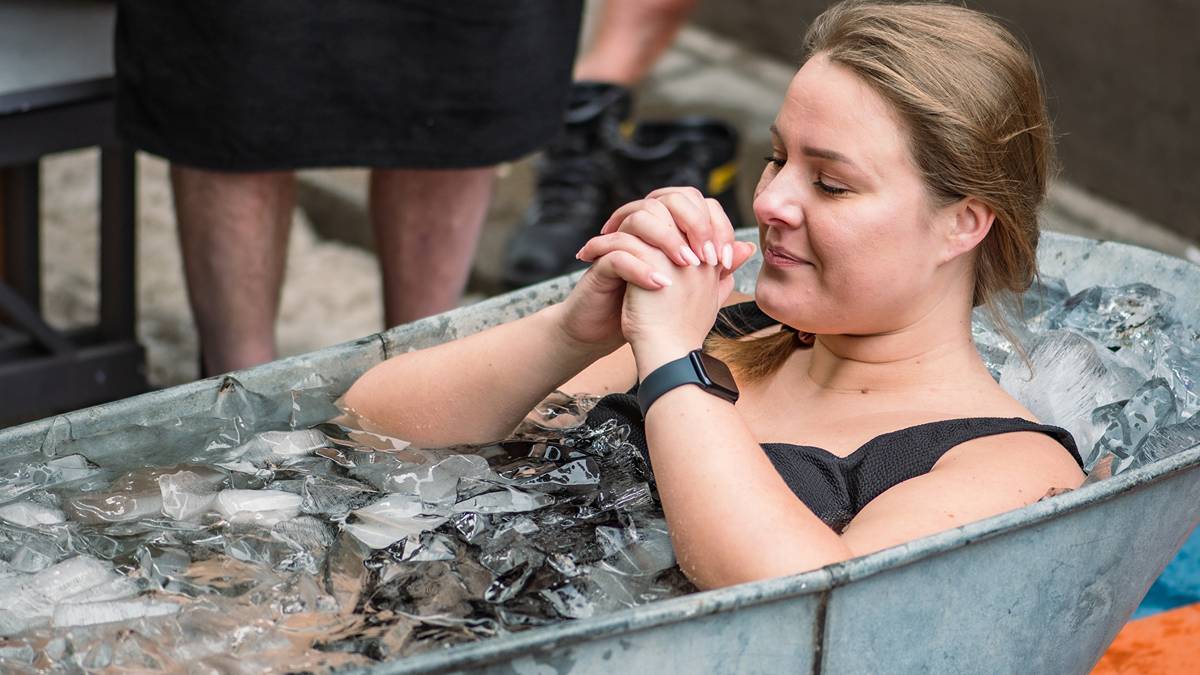The rise and fall of cold therapy: Why the hype around ice baths is starting to thaw

After a meteoric rise, the cold-plunge trend is starting to cool. Pic: Getty Images
Countless celebrities, athletes and biohackers swear by the benefits of cold plunges and co. But as new research emerges and some experts raise fresh concerns, what does the future hold for this low-temp trend, and are we about to see it frozen out of the health space? Body+Soul investigates.
Words by Alex Davies
On a sunny day in North Fremantle, a group gathers on the beach and prepares for a feat of physical and mental endurance. Each person climbs into one of 45 inflatable pools that are scattered on the sand like cerulean lollies, before settling into some breathwork or similar to pass the time. After three minutes, cheers break out and a new Guinness World Record is etched into history by 509 participants – for the biggest group ice bath in the world.
Once upon a toastier time, the idea of submerging your body in single-digit temps was pretty much reserved for elite athletes and extreme adventurers. But, fast forward to 2025 and cold-water immersion has firmly cemented itself on the wellness scene, whether it’s ice baths, cold plunges or fresh ocean swims in all seasons. That record-setting soak in 2024 even sparked the inaugural ‘International Ice Bath Day’ earlier this year.
If you haven’t dipped a toe in yourself, chances are that you’ve spotted any number of celebrities, biohackers and athletes alike taking the plunge on social media, from Body+Soul cover alumni Harry Garside and Joan MacDonald (aka, legend @trainwithjoan) to Rita Ora, Mark Wahlberg and Matildas stars – to name just a few – while Selena Gomez nodded to the soothing potential of cold water in a recent Vanity Fair interview.
Google searches for ‘What is a cold plunge?’ have increased by more than 5000 per cent in Australia over the past five years, as advocates say the wave of benefits can include everything from boosted recovery and sleep, to improved mental wellbeing and more.
The practice is big business, too. The global cold plunge tub market is tipped to be worth more than $800 million by 2032. Deep pockets can splash out on super-techy ones that cost thousands, while both Kmart and Aldi have gone viral for more affordable versions. You know a trend has gone mainstream when it hits the middle aisle, right?
But now, the chilling plot twist: an emerging group of experts is starting to give icy plunges the cold shoulder. Some argue the much-hyped practice isn’t actually suitable for everyone, with the impact on women in particular contention.
Dr Stacy Sims – renowned researcher and female physiology expert – recently spoke about women requiring a different approach than men, and in a June podcast interview, clinical nutritionist Sally O’Neil told host Nat Kringoudis: “I just hate [cold plunges] for most people.” Cue: not-so-cool confusion.
So, how did we get here, and what’s next for cold plunging? Let’s dive in.
Why ice baths boomed
Wondering what’s driven the evolution of cold immersion from an athletic niche to something your colleague/partner/barista fits into lunch breaks? One major factor is our collective shift into focusing on biohacking, and high-performance culture that’s made its way beyond sport, says exercise physiologist, Austin Smith.

Why ice baths boomed. Image: Supplied as appeared in Body + Soul
“The practice has become popular because it speaks to areas that we care about, whether that’s resilience, presence, physical optimisation or maybe a reset button in a pretty distracted world,” notes the founder of nature-based allied health group, The Green Movement Co, who does cold plunges himself.
“Mental health has become a greater conversation, with people looking for other ways to regulate mood and stress. Social media is a huge part of it, too. I think back to the ice bath challenge and then Wim Hof [the Dutch extreme athlete known for his cold exposure methods], as well as influencers posting their viral plunge clips.”
Johannes Egberts is a leading breathwork teacher, cold-therapy instructor and author of The Cold Therapy Plan: 28 Days to Reduce Stress, Enhance Sleep and Promote Recovery, who counts Garside among his fans. He agrees that online visibility and a star-studded fanbase have indeed fuelled this new ice age, but also points out the short-effort-high-reward appeal that keeps people coming back.
“It’s something you can do in a short space of time that can have a large impact on both mental and physical health,” Egberts tells Body+Soul. “I think cold exposure just really stands out because it’s so tangible, it’s so visceral. You simply cannot do it and not feel the difference.”
The very cool consequences
Ready to defrost some of the science? If you’ve ever had a date with cold water, you’ll be familiar with what’s known as the ‘cold shock response’.
As Smith explains, “”t’s the gasp and instant spike in breathing rate, heart rate, blood pressure and your body responding to stress. From this, one thing we see is vasoconstriction from the extremities – arms, hands, legs and so on – as your body brings blood in to protect the vital organs [and preserve] heat.”

If you’ve ever had a date with cold water, you’ll be familiar with what’s known as the ‘cold shock response’. Image: iStock as appeared in Body + Soul
The post-workout wins of the practice are partly tied to this mechanism. “There’s strong evidence that the vasoconstriction reduces blood flow to sore areas and changes the perception of delayed onset muscle soreness (DOMS),” says Smith.
“[Research also] suggests decrease of inflammation markers over time.” Chilling out can do your recovery a solid, too, because “the cold helps to restore neuromuscular function – the connection between our brain, spinal cord and muscles”.
On the flip side? A small-but-intriguing new Maastricht University study hints that an immediate post-training ice bath might dampen processes that drive muscle growth, although more research is needed.
When it comes to claims of a sharper mind, slashed stress, dreamier sleep and co? “We do see a [temporary] increase in adrenaline and dopamine, which can lead to mental alertness and a state change in the short term,” says Smith. He also points out that learning to calm ourselves – through slow breathing – activates our parasympathetic response and supports stress resilience over time.
“I would say the evidence is only moderate, subjective or emerging around things like improved sleep, mental grit, pain tolerance, etc. For me, the practice almost always helps with my mental clarity and mood regulation.”
It’s wise to recognise that effects vary with individuals, timing and other factors, and Smith encourages keeping claims in context – there’s one about cold water revving metabolism, for example, which he believes can be overhyped.
Researchers are clearing through the waters, too. In January, a University of South Australia team unveiled a deep dive on cold-water immersion, with the most comprehensive review and meta-analysis of its kind.
It found the activity may lower stress, improve sleep and boost quality of life, but very little evidence to support reports of bolstered immunity and mood. They also highlighted nuances and gaps, like many studies being done only on males (more on that shortly).

Cold plunges may lower stress, improve sleep and boost quality of life, but very little evidence to support reports of bolstered immunity and mood. Image: iStock as appeared in Body + Soul
Lead researcher Tara Cain, a project manager at UniSA, reveals there’s more detective work on the horizon.
“We’re putting together [a project] for next year to explore how cold-water immersion affects anxiety and depression,” she says.
““That will be super interesting. People are going to continue to do it, so the more evidence we can get out there about how it’s affecting the body will be great.”
Why we’re wet and wired
When O’Neil shared her tepid take during that podcast chat, she was speaking from experience, having dipped into cold plunges, icy tubs and wintery ocean swims.
As the women’s transformation strategist and Status8020 founder recalls to Body+Soul: “At first, the high was amazing – I felt switched on, sharp, energised. But very quickly, that tipped into feeling wired, overstimulated and exhausted. For me, cold immersion felt like I’d had three coffees back-to-back. It lit me up, but not in a sustainable way that worked for my own body.”
While she believes it can be a powerful tool that some of her female clients thrive on (usually those with an already-solid foundation of self-care), the majority report feeling more frazzled than soothed – especially if they’re already running on fumes.
It’s insights like these that are sparking a conversation shift, as emerging research suggests female physiology responds differently to cold. There are calls for more exploration because, ultimately, can one ice bath really fit all?
“Many of the benefits we hear about cold plunges come from studies done on men, often in athletic or military settings,” says O’Neil.
“But women’s bodies respond differently to stressors, especially across different phases of the menstrual cycle or during perimenopause.
“I’d love to see a move towards more individualised and cycle-aware protocols, instead of blanket approval for all populations.”

Females may benefit more from cool water immersion (10 to 15/16°C), rather than ice. Image: Getty as appeared in Body + Soul
It might even be a case of turning up the temp. Dr Sims has spoken on socials and podcasts lately about females benefitting more from cool water immersion (10 to 15/16°C), rather than ice. The latter can be too much of a stress, she explains, and in turn counterproductive for wellbeing.
Dr Fatima Khan, peri and menopause specialist, agrees: “For women, especially during hormone transitions, extreme cold may be too stimulating,” notes the founder of Melbourne’s Menopause Clinic. “I often suggest milder temperatures – think a cool ocean swim or alternating hot and cold showers – rather than jumping into an ice bath.”
More invigorating intel? A 2024 UCL study found that some menopausal women who swam regularly in chilly water reported improvements in mental wellbeing, hot flushes and more. “I love that study,” says Dr Khan. “While the cold water likely plays a role, we need to consider the broader picture: movement, time in nature, social connection. It’s likely the whole ritual that’s therapeutic.”
A refreshing future
If you’re curious to take the plunge, Egberts encourages easing into the practice gradually, starting with cold showers, and treating it as part of a holistic wellbeing approach – not a magic fix or cure all.
And always err on the safe side by seeking medical advice if you’re unsure. “Some people have this idea that they need to go really cold in order to get the benefits, or do it for really long, but that’s not the case,” he says, adding that this misconception may be contributing to some of the recent pushback.
“There’s an idea that you need to do 10 minutes, which I never recommend. Two to three minutes is all that’s needed [for the general population].”
Be mindful of cautions and red flags: the stress of sudden cold can put those with heart conditions at particular risk, warns Smith, while pregnancy, circulatory issues and Raynaud’s are among other motivations to give it a miss.
“Heart palpitations, chest tightness, tunnel vision, nausea, panic, dizziness, feeling faint – these are signs to stop,” he says. “My golden rule? Pay attention to what your body’s saying – during and after – and always cold plunge with a partner.”

We’re entering an exciting new stage of decoding what’s right for you, regardless of what’s trending. Image: Getty as appeared in Body+Soul
As for what the future holds? Over to Egberts. “More personalised practice,” he predicts. “My feeling is, in a couple of years, your ice bath will tell you how much cold you’ll need today and at what temperature, based on your HRV, body temp and where you are in your training or cycle.” He also sees cold immersion flowing further into gyms, workplace wellbeing offerings, and beyond.
After a meteoric rise, there’s now a sense of the cold-plunge pendulum beginning to slowly swing back and find balance. As O’Neil points out, “The conversation is evolving, and that’s a really good thing.” From a growing pool of research to necessary questions about women’s health, we’re entering an exciting new stage of decoding what’s right for you, regardless of what’s trending – whether that involves chilling out in swimmers or otherwise. What could be cooler than that?
Is your temptation to plunge starting to defrost?
Tap into these alternatives instead, whatever your wellness goal – zero ice required.
For focus: a workout
Science suggests the brain boost from exercise can last a few hours, maybe even into the next day. As Dr Khan notes, regular movement – strength training and moderate cardio – has been linked to supporting mental focus and overall wellbeing.

Breathwork has remarkable benefits. Image: iStock as appeared in Body + Soul
For stress: vagus nerve TLC
Singing, humming, laughter and mindful movement are calming routines that can engage the body’s rest-and-digest response. These activities are sometimes linked to the vagus nerve, which plays a role in the parasympathetic nervous system.
For sleep: breathwork
Block out distractions, tune into your breath and prepare to snooze. “Breathwork has remarkable benefits,” says Egberts. “I recommend people start with lengthening their exhales – breathing in for a count of four, then out for a count of eight.”

Is your temptation to plunge starting to defrost? Image: Pexels as appeared in Body + Soul
For recovery: massage
Practices like myofascial release and massage are worth adding to your training toolkit, tips Smith. According to a review in the International Journal of Exercise Science, even the self-administered kind – think foam rollers, massage balls – can be beneficial.
This article first appeared in Body+Soul as The rise and fall of cold therapy: Why the hype around ice baths is starting to thaw
UNLOCK INSIGHTS
Discover the untold stories of emerging ASX stocks.
Daily news and expert analysis, it's free to subscribe.
By proceeding, you confirm you understand that we handle personal information in accordance with our Privacy Policy.








